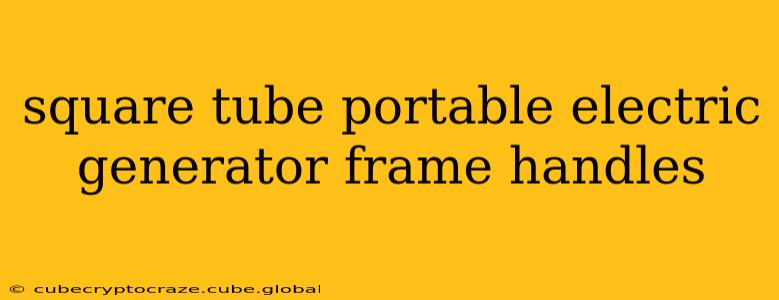Portable electric generators are invaluable during power outages, camping trips, or for powering tools on job sites. However, their weight and bulk can make them cumbersome to move. A sturdy, well-designed frame with handles is crucial for safe and easy transportation. This article explores the design considerations, fabrication techniques, and safety aspects of using square tubing to build portable generator frames with handles.
Why Square Tubing for Generator Frames?
Square tubing offers several advantages over other materials for constructing generator frames:
- Strength and Rigidity: Square tubing provides excellent strength-to-weight ratio, crucial for supporting the weight of a generator while remaining portable. Its rigid structure prevents flexing and wobbling during transport.
- Versatility: Square tubing can be easily welded, bolted, or otherwise fastened, allowing for flexible design options to accommodate generators of varying sizes and weights.
- Aesthetics: Square tubing provides a clean, professional look, enhancing the overall appearance of the generator frame.
- Availability: Square tubing is readily available from most metal suppliers and hardware stores in various sizes and thicknesses.
Designing the Frame and Handles: Key Considerations
The design of the frame should prioritize safety and ease of use. Here are some key considerations:
- Generator Dimensions: Precise measurements of the generator's dimensions (length, width, height, weight) are critical for determining the frame's size and structural requirements.
- Handle Placement and Ergonomics: Handles should be positioned for comfortable and balanced lifting. Consider the user's height and the generator's center of gravity. Properly placed handles minimize strain on the back and arms.
- Material Thickness: The thickness of the square tubing should be chosen based on the generator's weight and anticipated usage. Heavier generators require thicker tubing for added durability and safety.
- Reinforcement: For larger, heavier generators, additional reinforcement may be necessary, such as gussets or bracing, to enhance the frame's structural integrity.
- Mounting System: The frame's mounting system should securely hold the generator in place, preventing movement or shifting during transport. Consider using straps, bolts, or other secure fastening mechanisms.
Fabrication Techniques: Building the Frame
Several methods can be used to fabricate the generator frame:
- Welding: Welding is a strong and durable method, creating a seamless and robust frame. It requires specialized equipment and skills.
- Bolting: Bolting is a simpler method requiring fewer specialized tools, although it may be slightly less strong than welding.
- Pre-fabricated Components: Ready-made components can be purchased and assembled, simplifying the process and requiring minimal fabrication skills.
Safety Precautions During Construction and Use
Safety is paramount when working with metal and power tools. Here are some essential safety precautions:
- Personal Protective Equipment (PPE): Always wear appropriate PPE, including safety glasses, gloves, and a respirator when welding or working with metal.
- Proper Tool Use: Ensure all tools are used correctly and according to manufacturer instructions.
- Welding Safety: If welding, work in a well-ventilated area and use proper safety precautions to avoid burns and inhalation of fumes.
- Secure Mounting: Ensure the generator is securely mounted to the frame to prevent it from shifting during transport.
- Lifting Techniques: Use proper lifting techniques to avoid injury. Consider using lifting straps or other assistive devices for heavy generators.
What materials are best for a generator frame?
The best materials for a generator frame are strong, lightweight, and corrosion-resistant. Square steel tubing is a popular choice due to its strength and affordability. Aluminum tubing is another option, offering a lighter weight but potentially at a higher cost. Consider the weight of your generator and your budget when choosing a material.
How do I secure a generator to its frame?
Securely fastening the generator to the frame is crucial for safety. Several methods exist, including using straps, bolts, or a combination of both. Straps offer flexibility, while bolts provide a more rigid connection. Ensure the fastening method is strong enough to prevent the generator from shifting during transport.
What is the best size square tubing for a generator frame?
The ideal size of square tubing depends on the weight and size of your generator. Heavier generators require thicker and larger tubing for adequate support. Consult load capacity charts and consider using a safety factor when selecting tubing size.
Conclusion
Building a custom frame with handles significantly improves the portability and safety of using a portable electric generator. By carefully considering design, material selection, and fabrication techniques, you can create a durable and user-friendly solution for transporting your generator. Remember that safety should always be the top priority throughout the design, construction, and use of the frame.
